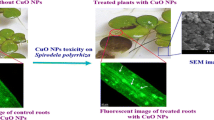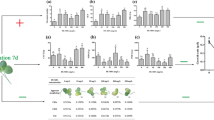Abstract
Recently, the application of copper oxide nanoparticles (CuO-NPs) has increased considerably, primarily in scientific and industrial fields. However, studies to assess their health risks and environmental impacts are scarce. Therefore, the present study aims to evaluate the toxicological effects of CuO-NPs on the duckweed species Landoltia punctata, which was used as a test organism. To accomplish this, duckweed was grown under standard procedures according to ISO DIS 20079 and exposed to three different concentrations of CuO-NPs (0.1, 1.0, and 10.0 g L−1), with one control group (without CuO-NPs). The toxicological effects were measured based on growth rate inhibition, changes in the plant’s morphology, effects on ultrastructure, and alterations in photosynthetic pigments. The morphological and ultrastructural effects were evaluated by electronic, scanning and light microscopic analysis, and CuO-NPs were characterized using transmission electron microscopy (TEM), zeta potential, and superficial area methods of analysis. This analysis was performed to evaluate nanoparticle size and form in solution and sample stability. The results showed that CuO-NPs affected morphology more significantly than growth rate. L. punctata also showed the ability to remove copper ions. However, for this plant to be representative within the trophic chain, the biomagnification of effects must be assessed.





Similar content being viewed by others
References
Appenroth KJ, Luther A, Jetschke G, Gabrys H (2008) Modification of chromate toxicity by sulphate in duckweeds (Lemnaceae). Aquat Toxicol 89:167–171
Appenroth KJ, Krech K, Keresztes Á, Fischer W, Koloczek H (2010) Effects of nickel on the chloroplasts of the duckweeds Spirodela polyrhiza and Lemna minor and their possible use in biomonitoring and phytoremediation. Chemosphere 78:216–223
Axtell NR, Sternberg SP, Claussen K (2003) Lead and nickel removal using microspora and Lemna minor. Bioresour Technol 89:41–48
Chiang CY, Aroh K, Ehrman SH (2012) Copper oxide nanoparticle made by flame spray pyrolysis for photoelectrochemical water splitting e Part I. CuO nanoparticle preparation. Int J Hydrogen Energ 37:4871–4879
Crosera M, Bovenzi M, Maina G, Adami G, Zanette C, Florio C, Larese FF (2009) Nanoparticle dermal absorption and toxicity: a review of the literature. Int Arch Occup Environ Health. doi:10.1007/s00420-009-0458-x
Das D, Nath BC, Phukon P, Dolui SK (2013) Synthesis and evaluation of antioxidant and antibacterial behavior of CuO nanoparticles. Colloids Surf B: Biointerfaces 101:430–433
Drost W, Matzke M, Backhaus T (2007) Heavy metal toxicity to Lemna minor: studies on the time dependence of growth inhibition and the recovery after exposure. Chemosphere 67:36–43
Fernandes JC, Henriques FS (1991) Biochemical, physiological, and structural effects of excess copper in plants. Bot Rev. doi:10.1007/BF02858564
Gouveia C, Kreusch M, Schmidt EC, Felix MRL, Osorio LKP, Pereira DT, Santos R, Ouriques LC, Martins RP, Latini A, Ramlov F, Carvalho TJG, Chow F, Maraschin M, Bouzon ZL (2013) The effects of lead and copper on the cellular architecture and metabolism of the red alga gracilaria domingensis. Microsc Microanal 19:513–524
Gubbins EJ, Batty LC, Lead JR (2011) Phytotoxicity of silver nanoparticles to Lemna minor L. Environ Pollut 159:1551–1559
Hiscox JD, Israelstam GF (1979) A method for the extraction of chlorophyll from leaf tissue without maceration. Can J Bot 57:1332–1334
Hou W, Chen X, Song G, Wang Q, Chang CC (2007) Effects of copper and cadmium on heavy metal polluted waterbody restoration by duckweed (Lemna minor). Plant Physiol Biochem 45:62–69
ISO 20079 (2005) Water quality—determination of toxic effect of water constituents and waste water to duckweed (Lemna minor)—Duckweed growth inhibition test. DRAFT INTERNATIONAL STANDARD
Juhel G, Batisse E, Hugues Q, Daly D, van Pelt FNAM, O’Halloran J, Jansen MAK (2011) Alumina nanoparticles enhance growth of L. minor. Aquat Toxicol 105:328–336
Khellaf N, Zerdaoui M (2010) Growth, photosynthesis and respiratory response to copper in Lemna minor: a potential use of duckweed in biomonitoring. Iran J Environ Health Sci Eng 7(4):299–306
Li L, Sillanp M, Tuominen M, Lounatmaa K, Schultz E (2013) Behavior of titanium dioxide nanoparticles in Lemna minor growth test conditions. Ecotoxicol Environ Saf 88:89–94
Marchand L, Mench M, Marchand C, Le Coustumer P, Kolbas A, Maalouf JP (2011) Phytotoxicity testing of lysimeter leachates from aided phytostabilized Cu-contaminated soils using duckweed (Lemna minor L.). Sci Total Environ 410–411:146–153
Miao AJ, Schwehr KA, Xu C, Zhang SJ, Luo Z, Quigg A, Santschi PH (2009) The algal toxicity of silver engineered nanoparticles and detotoxification by exopolymeric substances. Environ Pollut. doi:10.1016/j.envpol.2009.05.047
Naumann B, Eberius M, Appenroth KJ (2007) Growth rate based dose–response relationships and EC-values of ten heavy metals using the duckweed growth inhibition test (ISO 20079) with Lemna minor L. clone St. J Plant Physiol 164:1656–1664
Navarro E, Baun A, Behra R, Hartmann NB, Filser J, Miao AJ, Quigg A, Santschi PH, Sigg L (2008) Environmental behavior and ecotoxicity of engineered nanoparticles to algae, plants, and fungi. Ecotoxicol. doi:10.1007/s10646-008-0214-0
OECD (2002) Guidelines for the testing of chemicals: revised proposal for a new guideline 221—Lemna sp. Growth Inhibition Test. http://www.oecd.org/chemicalsafety/testing/1948054.pdf. Accessed 26 Sept 2013
Patsikka E, Kairavuo M, Sersen F, Aro EM, Tyystjarvi E (2002) Excess copper predisposes photosystem II to photoinhibition in vivo by outcompeting iron and causing decrease in leaf chlorophyll. Plant Physiol. doi:10.1104/pp.004788
Perreault F, Oukarroum A, Pirastru L, Sirois L, Matias WG, Popovic R (2010) Evaluation of copper oxide nanoparticles toxicity using chlorophyll a fluorescence imaging in Lemna gibba. J Bot. doi:10.1155/2010/763142
Perreault F, Samadani M, Dewez D (2013) Effect of soluble copper released from copper oxide nanoparticles solubilisation on growth and photosynthetic processes of Lemna gibba L. Nanotoxicology. doi:10.3109/17435390.2013.789936
Powers KW, Palazuelos M, Moudgil BM, Roberts SM (2007) Characterization of the size, shape, and state of dispersion of nanoparticles for toxicological studies. Nanotoxicology. doi:10.1080/17435390701314902
Prasad MNV, Malec P, Waloszek A, Bojko M, Strzalka K (2001) Physiological responses of Lemna trisulca L. (duckweed) to cadmium and copper bioaccumulation. Plant Sci. doi:10.1016/S0168-9452(01)00478-2
Quina FH (2004) Nanotecnologia e o meio ambiente: perspectivas e riscos. Quim Nova. doi:10.1590/S0100-40422004000600031
Radić S, Babić M, Skobić D, Roje V, Pevalek-Kozlina B (2010) Ecotoxicological effects of aluminum and zinc on growth and antioxidants in Lemna minor L. Ecotoxicol Environ Saf 73:336–342
Reynolds ES (1963) The use of lead citrate at high pH as an electron-opaque stain in electron microscopy. J Cell Biol 17:208–212
Rosseto ALOF (2012) Estudo comparativo entre os efeitos tóxicos agudos e crônicos do óxido de cobre na forma de nanopartícula e micropartícula. Dissertation, Universidade Federal de Santa Catarina
Schmidt ÉC, Rover T, Scariot L, Bouzon ZL (2009) Changes in ultrastructure and histochemistry of two red macroalgae strains of Kappaphycus alvarezii (Rhodophyta, Gigartinales), as a consequence of ultraviolet B radiation exposure. Micron 40:860–869
Schmidt ÉC, Maraschin M, Bouzon ZL (2010a) Effects of UVB radiation on the carragenophyte Kappaphycus alvarezii (Rhodophyta, Gigartinales): changes in ultrastructure, growth, and photosynthetic pigments. Hydrobiologia 649:171–182
Schmidt ÉC, Nunes BG, Maraschin M, Bouzon ZL (2010b) Effect of ultraviolet-B radiation on growth, photosynthetic pigments, and cell biology of Kappaphycus alvarezii (Rhodophyta, Gigartinales) macroalgae brown strain. Photosynthetica 48:161–172
Schmidt ÉC, Santos R, Horta PA, Maraschin M, Bouzon ZL (2010c) Effects of UVB radiation on the agarophyte Gracilaria domingensis (Rhodophyta, Gracilariales): changes in cell organization, growth and photosynthetic performance. Micron 41:919–930
Schmidt ÉC, Pereira B, Santos R, Gouveia C, Costa GB, Faria GSM, Scherner F, Horta PA, Paula MR, Latini A, Ramlov F, Maraschin M, Bouzon ZL (2012) Responses of the macroalgae Hypnea musciformis after in vitro exposure to UV-B. Aquat Bot 100:8–17
Sharma SS, Gaur JP (1995) Potential of Lemna polyrrhiza for removal of heavy metals. Ecol Eng 4:37–43
Shaw AJ (1989) Heavy metal tolerance in plants: evolutionary aspects. CRC Press, New York, 355p
Shi J, Abid AD, Kennedy IM, Hristova KR, Silk WK (2011) To duckweeds (Landoltia punctata), nanoparticulate copper oxide is more inhibitory than the soluble copper in the bulk solution? Environ Pollut 159:1277–1282
Upadhyay R, Panda SK (2010) Zinc reduces copper toxicity induced oxidative stress by promoting antioxidant defense in freshly grown aquatic duckweed Spirodela polyrhiza L. J Hazard Mater 175:1081–1084
Wang Z, Li J, Zhao J, Xing B (2011) Toxicity and internalization of CuO nanoparticles to prokaryotic alga Microcystis aeruginosa as affected by dissolved organic matter. Environ Sci Technol 45:6032–6040
Wellburn AR (1994) The spectral determination of chlorophylls a and b, as well as total carotenoids, using various solvents with spectrophotometers of different resolution. J Plant Physiol 144:307–313
Zha LY, Xu ZR, Wang MQ, Gu LY (2007) Chromium nanoparticle exhibits higher absorption efficiency than chromium picolinate and chromium chloride in Caco-2 cell monolayers. J Anim Physiol Anim Nutr. doi:10.1111/j.1439-0396.2007.00718
Acknowledgments
This work was supported by research grants from Coordenação de Aperfeiçoamento de Pessoal de Nível Superior (CAPES) and Conselho Nacional de Desenvolvimento Científico e Tecnológico (CNPq), Brazil. The authors thank the LCME (Central Laboratory of Electronic Microscopy at Federal University of Santa Catarina) and Dr. José Julio Barrios Restrepo (Federal University of Santa Catarina) for their kind assistance.
Conflict of interest
The authors declare that they have no conflict of interest.
Author information
Authors and Affiliations
Corresponding author
Additional information
Handling Editor: DAMJANA Drobne
Rights and permissions
About this article
Cite this article
Lalau, C.M., Mohedano, R.d.A., Schmidt, É.C. et al. Toxicological effects of copper oxide nanoparticles on the growth rate, photosynthetic pigment content, and cell morphology of the duckweed Landoltia punctata . Protoplasma 252, 221–229 (2015). https://doi.org/10.1007/s00709-014-0671-7
Received:
Accepted:
Published:
Issue Date:
DOI: https://doi.org/10.1007/s00709-014-0671-7




